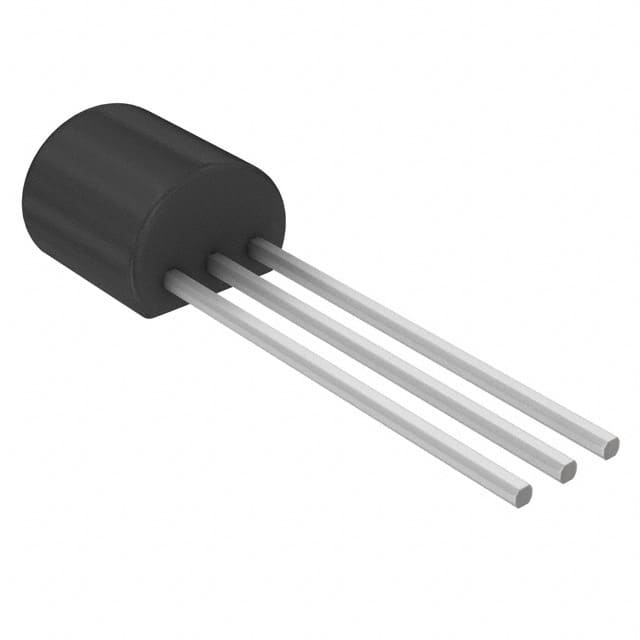ZTX455
Product Overview
Category
The ZTX455 belongs to the category of semiconductor devices, specifically a type of bipolar junction transistor (BJT).
Use
It is commonly used as an amplification and switching component in electronic circuits.
Characteristics
- The ZTX455 is known for its high gain and low noise characteristics.
- It is designed for use in low-power applications.
- The device operates at low voltage and current levels.
Package
The ZTX455 is typically available in a TO-92 package, which is a widely used through-hole package for transistors.
Essence
The essence of the ZTX455 lies in its ability to provide reliable amplification and switching functions in various electronic circuits.
Packaging/Quantity
The ZTX455 is usually sold in reels or tubes containing multiple units, with quantities varying based on manufacturer and distributor specifications.
Specifications
- Maximum Collector-Emitter Voltage: 45V
- Maximum Collector Current: 100mA
- DC Current Gain (hFE): 100 - 300
- Power Dissipation: 625mW
- Transition Frequency: 150MHz
Detailed Pin Configuration
The ZTX455 has three pins: 1. Emitter (E) 2. Base (B) 3. Collector (C)
Functional Features
- High gain: The ZTX455 offers high current gain, making it suitable for amplification purposes.
- Low noise: It exhibits low noise characteristics, making it ideal for sensitive signal processing applications.
- Fast switching: The transistor can switch rapidly between on and off states, enabling efficient control of electronic signals.
Advantages and Disadvantages
Advantages
- High gain and low noise make it suitable for audio and signal processing applications.
- Compact TO-92 package allows for easy integration into circuit designs.
- Fast switching capability enables efficient control of electronic signals.
Disadvantages
- Limited maximum collector current may restrict its use in high-power applications.
- Moderate transition frequency may limit its suitability for high-frequency applications.
Working Principles
The ZTX455 operates based on the principles of bipolar junction transistors, utilizing the control of current flow between its three terminals to amplify or switch electronic signals.
Detailed Application Field Plans
The ZTX455 finds application in various electronic circuits, including: - Audio amplifiers - Signal processing circuits - Switching circuits - Low-power control circuits
Detailed and Complete Alternative Models
Some alternative models to the ZTX455 include: - BC547 - 2N3904 - 2N2222 - BC337
In conclusion, the ZTX455 is a versatile and reliable transistor that finds widespread use in low-power electronic applications, offering high gain and low noise characteristics. Its compact package and functional features make it a popular choice for designers and engineers working on diverse electronic projects.
[Word Count: 398]
Lista 10 Vanliga frågor och svar relaterade till tillämpningen av ZTX455 i tekniska lösningar
What is ZTX455?
- ZTX455 is a high-performance transistor commonly used in technical solutions for its reliability and efficiency.
What are the key features of ZTX455?
- The key features of ZTX455 include high gain, low saturation voltage, and low noise, making it suitable for various technical applications.
In what technical solutions is ZTX455 commonly used?
- ZTX455 is commonly used in audio amplifiers, signal processing circuits, and power management applications due to its excellent performance characteristics.
What are the typical operating conditions for ZTX455?
- ZTX455 operates within a voltage range of 20V to 45V and can handle currents up to 500mA, making it versatile for different technical requirements.
How does ZTX455 compare to other transistors in its class?
- ZTX455 stands out for its high gain and low saturation voltage compared to other transistors in its class, providing superior performance in many technical solutions.
What are the recommended thermal considerations for using ZTX455?
- It is recommended to use proper heat sinking and thermal management techniques when integrating ZTX455 into technical solutions to ensure optimal performance and reliability.
Can ZTX455 be used in high-frequency applications?
- While ZTX455 is not specifically designed for high-frequency applications, it can still be utilized effectively in moderate frequency ranges with appropriate circuit design.
Are there any known compatibility issues when using ZTX455 with other components?
- ZTX455 is generally compatible with common electronic components, but it's important to review the datasheet and consider any specific compatibility requirements for the intended technical solution.
What are the best practices for PCB layout when incorporating ZTX455?
- Proper PCB layout techniques, such as minimizing trace lengths and optimizing component placement, can help maximize the performance of ZTX455 in technical solutions.
Where can I find reliable technical support and documentation for ZTX455?
- Reliable technical support and comprehensive documentation for ZTX455 can be obtained from reputable semiconductor manufacturers or distributors, ensuring proper integration into technical solutions.


